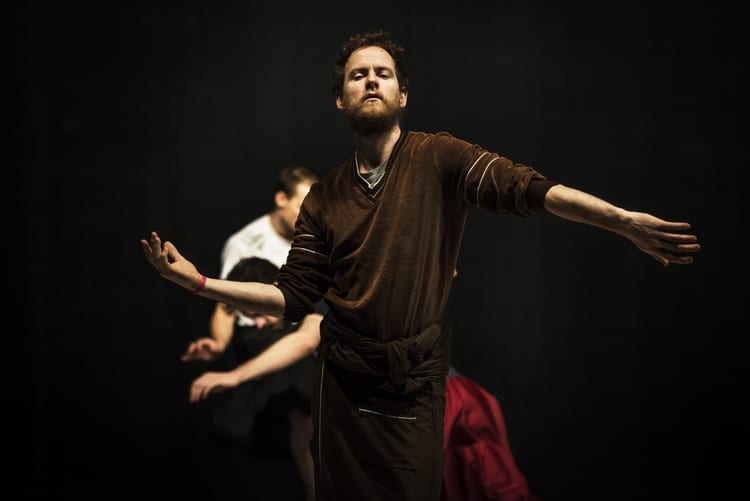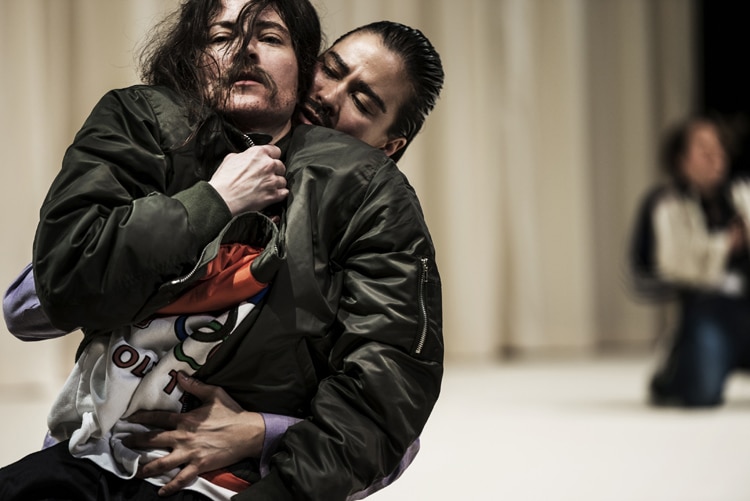Twee choreografen die onderzoeken hoe een danser en het oog van het publiek op elkaar inwerken. Dansmakers die rammelen aan de gangbare ideeën over identiteit en seksualiteit. Kunstenaars die ons confronteren met de dromen over perfectie en glamour waar reclame en marketing ons mee opschepen. Het beroemde Cullberg Ballet maakte een opvallende keuze door choreografieën uit te voeren van de Amerikaan Trajal Harrell en de Hongaars/Franse Eszter Salamon. Hoewel de dansers prachtig dansen, blijft de avond steken in statements. Doel lijkt vooral het publiek aan het denken te zetten.

‘De ziel van de moderne dans terugbrengen.’ Dit beloven de zes Cullberg-dansers aan het begin van ‘The Return of the Modern Dance’ van Harrell. Weg met de vertroebeling van de afgelopen decennia. Een ingewikkeld web van vragen heeft zich over de moderne dans gelegd. Wat voor identiteit dragen dansers uit? Welke krachten bepalen hun dans en de manier waarop het publiek deze dans bekijkt? Politiek, emotie, psychologie, erotiek, taal, ras, gender? Wat ze terug willen is: persoonlijke expressie.
Maar waar blijft die individualiteit in deze voorstelling? Alles verschilt zo weinig van elkaar: de solo’s met golvende rompen, schouders en armen, de groepspassages met eenvoudige motieven, uitlopend op pasjes als van soldaatjes op een rij. Je ziet uitgeklede verwijzingen naar moderne dans van andere choreografen, maar waar breken deze dansers door dit materiaal heen, zodat hun eigen drijfveren zichtbaar worden? Er groeit geen spanning in de sobere bewegingen. De muziek is divers, maar alle nummers verspreiden dezelfde lome sfeer in de zaal. De dansers trekken vrouwenkleren aan, maar daar gebeurt verder zo weinig mee!
Wat moet ik er als toeschouwer mee? Pas aan het eind komt er iets meer pit in de choreografie. Maar de bevrijde manier waarop de dansers over het toneel wervelen is ook zo minimaal, zo weinig uitgesproken! Waar blijft die ziel van de moderne dans, vraag ik me hierbij af. Maar dan gaat het licht al uit.

Het gegeven van ‘Reproduction’ van Eszter Salamon is eenvoudig samen te vatten. Acht mannen nemen alle tijd om voor het publiek te seksen, in alle standen en posen die ze kunnen bedenken. Eerst zijn ze echte mannen, besnord en stoer, en doen ze het twee aan twee. Later, als ze zich in uitgekiende vrouwenkleren hebben gehuld, volgt meer het groepswerk, vermengd met catwalkmaniertjes. Bijzonder kenmerk is dat ze deze hele act, van begin tot eind, in een extreem vertraagd tempo doen.
Dit laatste brengt je op de gedachte dat de choreografe je ergens over wil laten nadenken. Dat ging ik dan ook doen. De traagheid en de stilte maken maken seks weinig reëel. Het is de verre droom die mode, media en marketing ervan maken. Ik kwam bij de showachtige en later (gl)amoureuze beelden ook nog op de gedachte: geven we echt onszelf als we volgens de norm van media en reclame de liefde bedrijven? En daaraan gekoppeld: willen we echt de ander zoals die is als we met iemand naar bed gaan of alleen geilen we alleen op het beeld, het uiterlijk? En na verloop van tijd dacht ik: zijn ze hier bezig uitvoerig een grap uit te rollen om het absurd clichématige te laten zien? En tenslotte maar weer eens de vraag: is dit dans?
Het is natuurlijk nuttig je dit soort vragen te stellen, maar in ‘Reproduction’ wordt het je wel moeilijk gemaakt. De voorstelling duurt zo lang, dat de vragen die in me opkwamen leegliepen als een ballonnetje. De inhoud is uiteindelijk zo dun en er gebeurt in wezen zo weinig! Van de weeromstuit houd je het met die bewustwording voor gezien. Zijn dit soort vragen niet al heel vaak gesteld? En zijn we langzamerhand niet zover dat we alle bewegingen als potentiële dans zien? Hoe wakkerschuddend ‘Reproduction’ ook bedoeld zal zijn, ik verliet de zaal met het gevoel: nu wil ik wel eens dans zien die me echt over grenzen brengt.
Nog te zien: za 20 en zo 21 juni, 20.30 u. (voorbespreking: 19.45 u.), Theater Bellevue, Amsterdam
Foto’s: Carl Thorborg
